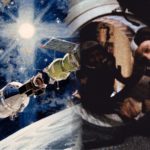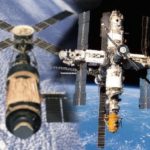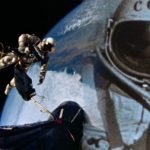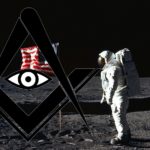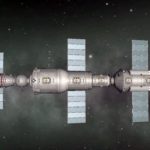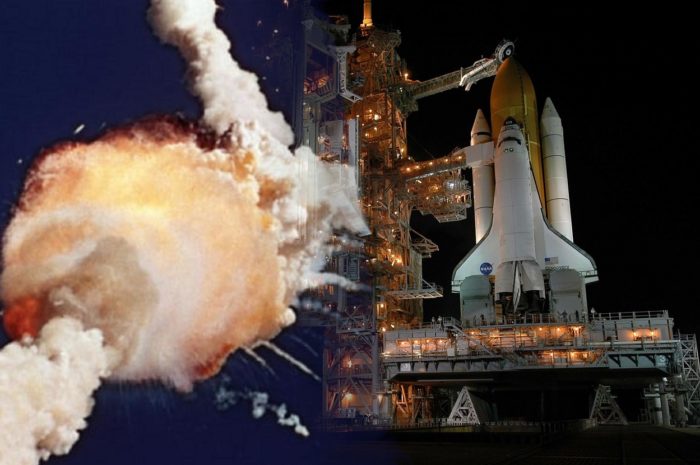
Success And The Realization Of A Nightmare: The Space Shuttle Era
- By
- April 11, 2021
- September 29, 2021
- 23 min read
- Posted in
- Space, History
As the 1970s morphed into the 1980s and the Reagan era of the United States, in what would prove to be the last decade of the Cold War as well as the last remnants of competitiveness in the Space Race, NASA looked to unleash its Space Shuttle program.
The general drive was to have spacecraft that were reusable and could be used for multiple missions, not least to assist in the building of a planned United States Space Station. And indeed, the initial plans and hopes for the Space Shuttle – that they would launch on a weekly basis – show how advanced those plans and ideas were.

The Space Shuttle era, despite the tragedies, is a classic era in space exploration
Operating from 1981 to 2011 NASA launched a total of 134 shuttle missions. However, the realization of such achievements as the Moon landings was not expanded. What’s more, two deadly disasters occurred during the lifetime of the program, claiming the lives of 14 astronauts leading to many questions being asked as to the overall success of the program in the years that followed.
While we do not have space, nor time to examine each and every shuttle flight here, we will examine the two disasters in full (and even each of these could fill entire volumes in their own right). We will also examine, again briefly, some of the reasons for the space shuttle, as well as the consequences, both intended and unintended.
That the Space Shuttle era will be one of the most remembered in the history of space exploration is without a doubt. It is, though, a mix of success, progress, and tragedy.
Contents
- 1 A “Space Truck” Into Space – The Beginning Of The Shuttle Program
- 2 The Space Shuttle Program Becomes A Reality
- 3 It Finally Happened – The Challenger Disaster
- 4 The “Return-To-Flight” Shuttle Missions
- 5 “Arrogant Complacency” – The Columbia Disaster
- 6 The End Of The Space Shuttle Era
- 7 All In All, Was The Shuttle Program (A Partial) Failure?
- 8 The Affects Of The Shuttle Program On The Soviet Union
- 9 The Validity Of The Space Shuttle Era
A “Space Truck” Into Space – The Beginning Of The Shuttle Program
The roots of the Space Shuttle Program and the Space Transportation System (STS) missions that took place across three decades from 1981 to 2011 stretch back to 1969 – the year the Apollo 11 crew landed on the moon. Although the official start of the Space Shuttle Program was in 1972 (even being labeled a potential “Space Truck” for regular flights into Earth orbit), it wasn’t until 1975 following Apollo-Soyuz missions that NASA turned their full attention, and budget, to it.
There had been several different designs and concepts of what the post-Apollo world should look like, with the Space Shuttle being just one. And indeed, many of these designs revolved around their use for the planned space station the United States intended to build (this project would, incidentally, stall in the mid-1980s and eventually become the International Space Station).
After finally being chosen, concerns immediately turned to the long-term financing of the program, which ultimately led to the involvement of the United States Air Force. They immediately went about putting their own slant on the Space Shuttle program, demanding that they take spy satellites into orbit as well as retrieve others, and even requesting they, on occasion, act as spies on the Soviet Union (we will examine this in more detail later).
The first test flights occurred in 1977 with five Approach and Landing flights taking place between August and October of that year. By the time the 1980s had announced themselves and Ronald Reagan had taken charge in the White House, the Space Shuttle program was ready to unveil itself to the world.
The short video below features footage of these test flights.
The Space Shuttle Program Becomes A Reality
Between April 1981 and January 1986, 24 successful Space Shuttle missions took place. [1] The first, the Columbia, launched on 12th April 1981, carrying two crew – mission commander John Young and pilot Robert Crippen – and spent just over 54 hours orbiting the planet before returning safely to Edwards Air Force Base. The flight was the first space flight to use reusable craft. Incidentally, the launch also took place on the 20th anniversary of Yuri Gagarin’s first flight in space (although this was due to a two-day delay in the launch as opposed to being planned.
The Columbia launched again seven months later on 12th November 1981, again with two crew members (Commander Joe Engle and pilot Richard Truly). They would spend around the same time in orbit as the first mission, testing several technological devices, including Shuttle Imaging Radar and the Canadarm (robotic arm) for the first time. The fourth Columbia mission on 27th June 1982 saw the first scientific and military payloads delivered into Earth’s orbit, including a missile detection system.
These first four flights were officially test flights for the shuttle vehicle, with the program becoming officially active and fully operational for all subsequent flights after that.
The first Challenger flight took place on 4th April 1983 and deployed key tracking and data satellites, while its second mission around two months later on 18th June 1983 featured the first American female astronaut to go into space, Sally Ride. Its third flight on 30th August saw another first when Guion Bluford became the first African American to go into space.
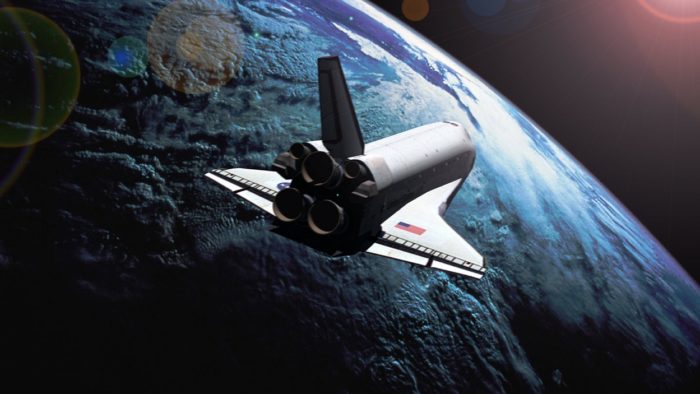
The initial hopes of the Space Shuttle Program were ambitious
The first Discovery mission launched on 30th August 1984, with its third mission a little under six months launching on 24th January 1985 being the first of a classified Department of Defense nature. When the Discovery flew again on 12th April 1985, it carried with it the first politician into space, Jake Garn, while its next flight launching on 17th June 1985 would take the first royal into space, Sultan bin Salman Al Saud. When the Atlantis launched on the 26th November 1985 it carried with it the first Mexican into space, Rodolfo Neri Vela.
Although they weren’t progressing at one a week, the Space Shuttle program was largely, at least initially, seen as a complete success. Each of the 24 shuttle missions brought with it further revelations of working in Earth’s orbit which, in turn, resulted in tweaks and improvements to the vehicle. They also took non-astronauts into space and so maintained an external interest and focus on the power and technological savvy of the United States space program.
As we shall see, though, the 25th mission, taking place a little over two weeks after the Columbia mission (STS-61-C) had successfully completed, would be one that would be remembered. And for all the wrong reasons, including an apparent improvement that had been overlooked for several years by several senior figures.
Before we move on to that, though, check out the video below. It features footage of the very first Space Shuttle launch.
It Finally Happened – The Challenger Disaster
By the time of the Challenger space mission of January 1986, there was a misplaced confidence in the shuttle program. And it was about to unveil itself to the whole world.
Like several previous shuttle missions, STS-51-L would feature a first as part of its crew when Christa McAuliffe became the first teacher into space. The rest of the crew comprised of Commander Francis Scobee, Pilot Mike Smith, Mission Specialists Ellis Onizuka, Judith Resnick, and Ronald McNair, and Payload Specialist, Greg Jarvis. It was a mission that would end in disaster and one from which none of them would return.
Perhaps one of the reasons for the disaster was the unusually cold weather.
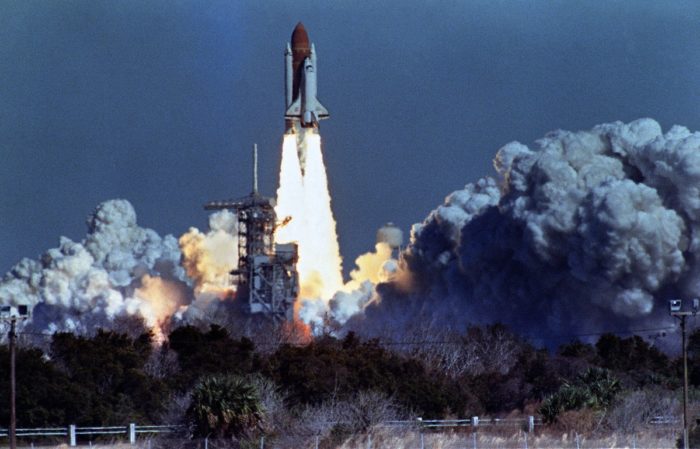
The Challenger lifitng off
Writing in “Live From Cape Canaveral”: Covering the Space Race, from Sputnik to Today, Jay Barbree stated how a “frigid weather front rolled southward out of Canada and headed straight for Florida”. So much so that “Florida’s sprawling Kennedy Space Center (came) to a slow crawl”.
He would continue that in the early hours of the morning of the planned Challenger launch, the 28th January, the “temperatures fell to below freezing”. As the hours went by, though, the sun finally brought the temperature closer to a more Florida-like climate. The launch had already been delayed for several days because of the weather. Now, however, it appeared the mission would finally go ahead.
The astronauts got themselves into position in the Challenger, all eagerly excited for their mission, and all tragically unaware of their fate. As Barbree wrote, “in spite of the public relations portrait being painted, Challenger was in every respect a contained iceberg”. Eventually, when the standard 10-minute hold occurred at the T-minus nine-minute, it was clear that there was indeed a danger presented to the crew with the icy environment. The hold, this time, would be indefinite until the temperature had risen to above 40 degrees.
It was around 11 am when it was confirmed by mission control that the temperature was beginning to reach what had been agreed was an acceptable level.
Finally, the Challenger was ready for liftoff.
The Launch To Tragedy
At 11:39 am (Eastern Time), the Space Shuttle Challenger finally left the launch pad as millions watched around the world on their television sets.
Even at this initial stage of the launch, there was potential for disaster. As the cameras recorded the event, it was noticed that there was a slight puff of smoke from the field joint indicating the O-ring had failed on the right-hand solid rocket booster. However, at only two seconds after lift-off, solid fuel inside the booster (aluminum oxide particles) made a makeshift (and unintended) seal. Consequently, the Challenger continued its ascent.
In the previously mentioned book “Live From Cape Canaveral”, Jay Barbree writes:
Unaware they were in mortal danger the astronauts waxed enthusiastic, showing with excitement as Challenger hammered its way, higher and higher!
A little over 30 seconds later, however, the weather that had caused several delays, not to mention concern to some engineers, came into play once more. At an approximate altitude of 10,000 feet, a particularly strong horizontal wind shear of 84 miles per hour (hurricane speed) rocked the Challenger. So much so, that it ultimately caused the joint on the right-hand booster to come loose.
To those watching below and at home, the launch was proceeding as normal. However, just before the 60-second mark, cameras following the progress of the ascent noticed the black mist-like plume on the affected booster. In reality, this was gas escaping. Within two seconds very definite flames could be seen on the right-hand booster.
Barbree would write of the sight that “a tongue of dazzling flame burst through the joint opening, creating a fearsome blowtorch of immense power”. As this took place, the crew inside were unaware of anything wrong and continued to go through their engine checks with mission control.
However, as the flames worked their way up the right-hand side of the booster and ultimately the Challenger, at least one astronaut, Mike Smith, who was in the ride-side pilot seat can be heard to say “Uh-oh!” before, at an approximate altitude of 48,000 feet, the shuttle ripped apart.
Barbree, who watched the events unfold from the press area near the launch site, recalled that there was “no explosion, just an instantly growing monster of fire where metal tore” and where it “shattered into burning jagged debris”. This debris continued upward for several moments before “cartwheeling through curving arcs” and finally beginning its final and tragic descent. There was no doubt that those on board the Challenger were dead.
You can view that footage, as it happened, below.
The Aftermath
Although NASA had suffered fatal setbacks previously, there was little doubt that what had just occurred over Florida was the worst to ever unfold.
Those below at the gathering points to watch the launch – including members of the astronauts’ families – looked up in disbelief. News channels around the world, while realizing that no-one could have survived what they had just witnessed, could not confirm, officially, that all had lost their lives.
While there was shock spread throughout all who witnessed the tragic events, some of the engineers and others involved in the launch were beginning to return to the weather and the potential for problems with the O-rings.
Writing in “Live From Cape Canaveral”, Jay Barbree noted that “the freeze had robbed the critical O-ring of its ability to flex, to expand and seal”. Because of this, the rotation of the booster created a tiny gap. However, it was enough for disaster to unfold.
In reality, there were concerns that the O-rings might fail as far back as 1971 when tests using pressurized water showed that the O-rings began to bend away from each other as opposed to closing tighter as they were supposed to do. This, of course, meant that the likeliness of gases escaping increased.
What’s more, these concerns were brought up on several occasions to the manager of the Solid Rocket Booster project, George Hardy by Thiokol engineers (who made the parts concerned). These concerns, essentially, were ignored. Even in the months leading up to the launch of the Challenger there were continued concerns of the very real potential for disaster to unfold as a result of the O-rings not working as they should.
Barbree would continue that even during the delay waiting for the temperature to rise “any first-year engineering student should have known” that the “warmth of the sun on the outside could not solve the problem of the critical O-ring seals inside the rocket boosters”. They would, regardless of what temperature rises occurred on the outside, remain cold. And consequently, weakened.
An “Acceptable Risk” For Future Missions
In the book Challenger: An American Tragedy: The Inside Story from Launch Control, Hugh Harris examines further opportunities to halt the launch and ultimately save the lives of the astronauts. [2] He would write how rumors of a meeting between more than 30 Thiokol managers and other high-ranking individuals had taken place the night before the launch. He also goes on to state that while many such rumors swirl around after such events, “this one turned out to be true”.
What’s more, what they discussed were specific concerns about the O-rings and the freezing temperatures. And as we know, these general concerns regarding O-rings had seemingly been played down and dismissed for years.
Harris writes that “the Marshall solid motor managers had gotten used to seeing hot gasses get past the primary O-rings on the field joints and were trusting the secondary O-rings to prevent a breach”.
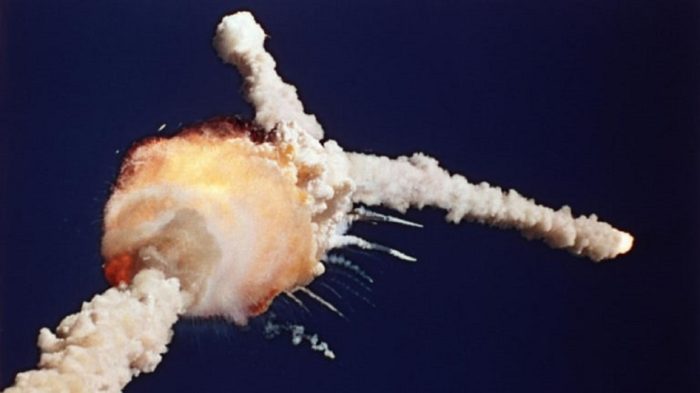
The immediate aftermath of the Challenger disaster
Harris also notes that ultimately, the two men who could have made a final decision to abort the launch – Launch Director Gene Thomas and Associate Administrator Jesse Moore – were at no time made aware of the concerns.
In “Live From Cape Canaveral” Jay Barbree claimed he spoke to the Marshall Space Flight Center’s manager at the Cape, Cecil Houston, several days after the incident in his job covering the incident for NBC. He claimed that Houston told him that “everybody signed off on it (the O-ring concerns), including Thiokol. We all agreed we should fly”. He also reveals that NASA officials were briefed by engineers from Thiokol once more before the launch about the potential issues with the O-rings. Their response was that it was an “acceptable risk” for future flights.
“Running Around, Pointing Fingers!”
We have mentioned and relied upon the work of Jay Barbree here – and with good reason given that he covered the NASA space launches for half a century and was key in covering the Challenger disaster, both at the time and in the days and weeks that followed. It was also thanks to Barbree’s journalism, at least in part, that the reasons for the disaster came to light.
NASA had been decidedly tight-lipped following the incident. So Barbree contacted the recently retired Sam Beddingfield as the deputy director of Shuttle Projects Management, who would eventually agree to use his “senior management badge” to wander around the facility and see just what was being said about the tragedy. In fact, when Barbree initially spoke with Beddingfield about what might be happening at headquarters he was informed that “(senior management are likely) running around, pointing fingers, (and) protecting their asses”.
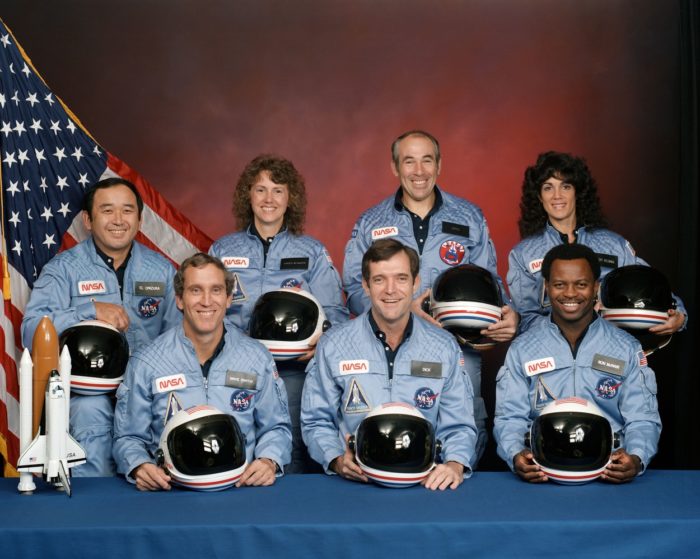
Challenger crew back row from left, Ellison S. Onizuka, Sharon Christa McAuliffe, Greg Jarvis and Judy Resnik. Front row from left Mike Smith, Dick Scobee and Ron McNair.
Within 24 hours of agreeing to observe what was being said for Barbree, Beddingfield reported back. He would confirm that the cause of the disaster was “an O-ring leak”, something that pictures and still frames from the cameras clearly showed. After speaking with senior figures at NBC, Barbree, along with Tom Brokaw, broke the story to the American public.
The Grim Revelations Of Recovery
The bodies of the Challenger crew were finally located on 7th March, with the announcement of their recovery coming on the 9th March. Initial rescue attempts had begun immediately following the incident. However, due to still-falling debris, rescue ships were held back for around an hour. After the initial searches utilizing the United States Coast Guard, a specific Search, Recovery and Reconstruction team was put together at the start of February. A month later, they had located their desired, grim target. Divers on board the USS Preserver began the recovery mission.
What the recovery revealed was that the crew of the Challenger, at least some of them, had survived the initial break up of the shuttle, with the cabin section, twisted as it was, remaining intact. Four Personal Egress Air Packs (which provided around 5 minutes of air in an emergency) were also recovered, three of which had been activated (one of which was confirmed to be Mike Smith’s), perhaps suggesting an awareness after the break-up.
For how long this awareness might have been for, however, and whether any of them were conscious remains unknown. As does whether any of the crew were alive at the time the wrecked cabin hit the cold waters of the Atlantic Ocean, approximately just short of three minutes following the break-up. It is, though, perfectly feasible that at least some of the crew were alive at this point, if less likely that they were conscious.
It is perhaps worth reminding ourselves once again that, contrary to popular belief, [3] the Challenger didn’t explode. While the rocket boosters, and more specifically, the liquid oxygen and hydrogen that was spilling out of them turned into a huge fireball, the solid-fuel boosters continued to climb. The shuttle itself was literally torn apart, with the cabin section – designed to withstand a considerable beating – remaining fully intact.
Were The Warning Signs There For Years?
It is ultimately the conclusions of some that there had been warning signs for years within the NASA Space Shuttle program that disaster was potentially just around the corner. Specifically, in this case, the prolonged concern of engineers with the O-rings.
And we have examined similar concerns in past NASA programs of increased pressures from superiors. While there doesn’t appear to have been any pressure in the case of the Challenger disaster – whether internally or from outsiders with political interests – there was a feeling that the general attitude of at least some of the those in the high-ranking circles of NASA was a greatly contributing factor.
While it is perhaps understandable to stop short of accusing NASA of negligence, they were most definitely complacent. In short, while they realized there was a genuine problem with the O-rings and that they often didn’t work as they should, because they had never experienced any major incidents because of this, they simply ignored the issues as an “acceptable risk”.
What makes these revelations even harder to swallow, though, is that despite the disaster and the lessons that should have been learned from it, the general attitude that allowed them to remain ignored would rear its head once more in the early 2000s with another shuttle disaster.
The video below examines the Challenger Disaster a little further.
Conspiracies And Seemingly Crazy Claims Of The Challenger Disaster
As we might expect in the fallout of the Challenger disaster came several conspiracy claims. And while we should perhaps treat them with the pinch of salt they likely deserve, in the interests of balance, some of them are certainly worth mentioning here.
In the book The NASA Conspiracies: The Truth Behind the Moon Landings, Censored Photos, and The Face on Mars, researcher and author, Nick Redfern examines several of these. [4] According to Redfern’s research, for example, in late-2003, Martin Black, a “self-described private eye with an obsessive interest in conspiracy theories” would make some remarkable claims.
Essentially, Black claimed that one of the astronauts on board – Ellis Onizuka – had “firsthand knowledge” regarding extraterrestrial bodies that had been recovered by the United States military. And what’s more, following the Challenger mission of January 1986, he planned to make this knowledge public.
We should note that most, even those in conspiracy circles, dismiss Black’s claims. Not least as there appears to be not one shred of evidence to back them up. And we should also stress that our examination of them is not an endorsement of them, merely an examination and demonstration of how easy it is for anyone to make such claims if we automatically subscribe to them.
We are perhaps best served returning to Redfern’s summary of the claims who asks why the United States government would take such drastic measures when “presumably, any skilled and capable hitman could have taken out Onizuka in a far more down-to-earth and much less visible fashion”, going on to suggest a “car accident or a faked suicide”.
However, rather intriguingly, Redfern then turns his attention to another account that not only revolves around recovered alien bodies, but also had apparent connections to none other than Ellis Onizuka. Indeed, such claims could be where such people as Martin Black make get their claims from.
Redfern tells of the revelations of Leonard H. Stringfield, a former United States intelligence officer who claimed he had spoken with a close friend of the late astronaut in 1985, a man named Chris Coffey. Stringfield claimed that Coffey had in-depth conversations with Onizuka that revolved very much around the “controversial issue of crashed UFOs and dead aliens” which the United States military had in their possession. Make of that what you will.
The “Return-To-Flight” Shuttle Missions
The Challenger disaster grounded the Space Shuttle Program for almost three years. And when they finally launched the Discovery on the 29th September 1988 the world the crew was temporarily leaving behind was a far different one than it was in January 1986.
The Cold War, for example, for all intents and purposes was over with the imminent crumbling of the Soviet Union. The United States Space Station had morphed into a collaboration of countries around the world into what would become the International Space Station, itself a reaction to the Soviet’s own efforts at creating a permanent residence in space.
In fact, for the next decade and a half, many of the shuttle flights would be to assist in the building of the space station, as well as to relay vital cargo (we will examine the journey of the Space Station in a future article).
The first shuttle launch following the Challenger disaster, though, was very much a reserved affair, with the crew spending four days in space before returning safely to Earth, much to the relief of everyone involved. This was also the first shuttle mission where the crew had escape options open to them – something that previous shuttle crews didn’t have.
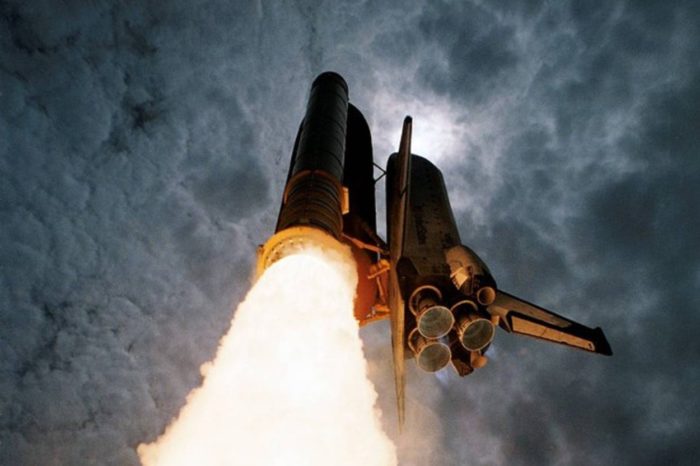
The Space Shuttle appeared to have recovered following the Challenger disaster
Several months later, on the 2nd December 1988, the Atlantis launched on another four-day mission. And while the mission was a success, there were chilling premonitions of another disaster waiting for NASA in the early 2000s when the Atlantis was damaged during take-off by falling debris. So much so, there were, privately, fears the shuttle might burn up on reentry. This proved not to be the case, but the issue of falling debris during take-off would come back to haunt the shuttle program around a decade and a half later.
However, throughout much of the 1990s, regular shuttle missions for a variety of reasons – including helping to launch and repair the Hubble Space Telescope – were completed successfully. Indeed, as the world entered the 2000s, it appeared that NASA had fully turned the corner and made the shuttle missions as safe as flying in an airplane.
However, those falling pieces of debris during lift-offs had continued to happen. And the more they happened without causing a major incident, the more NASA would seemingly see them as a minor (and acceptable) risk. That changed on 1st February 2003 with, coincidentally or not, the 113th Space Shuttle mission.
“Arrogant Complacency” – The Columbia Disaster
The launch of the Columbia on 16th January 2003 had, at least to everyone’s best knowledge at the time, gone exactly according to plan. However, as those at mission control and indeed in homes around the world watched live on their televisions for the return of the shuttle two weeks later, it became evident that something was wrong. By the time debris was filmed falling from the sky, it was all but confirmed that the Columbia had not survived its re-entry to Earth.
Much like managers were used to seeing the secondary O-rings make up for the weakening of the first ones in the run-up to the Challenger disaster, seeing the pieces of foam fall during the launch was seemingly another detail that was all-too-easily dismissed in the years leading to the second tragic loss of a space shuttle when the Columbia failed to return to Earth in February 2003.
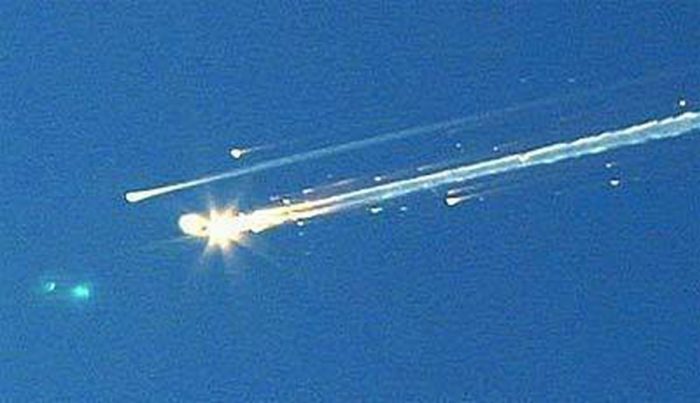
The falling debris of the Columbia
Writing in “Live From Cape Canaveral”, Jay Barbree notes that between the 87 missions that had taken place since the Challenger disaster and the upcoming Columbia mission, “an aura of what might best be called arrogant complacency pervaded the ranks of the agency’s senior management”. He would continue that, much like the attitude to the O-rings in the years leading up to the Challenger disaster, they had become “less tolerant of dissenting views”.
While foam falling from the external fuel tanks had occurred since the early years of the Space Shuttle program, as it had never resulted in any tragic incidents, it was now very much “a fact of life” for those within the agency.
This “arrogant complacency” would ultimately cost seven more astronauts their lives.
A “Normalization Of Deviance!”
Unlike many other shuttle missions, the Columbia that left the Earth on 16th January was not destined for the International Space Station but was instead to spend 16 days orbiting the planet carrying out various scientific experiments and studies.
The launch, although subject to several days delays, had appeared to go flawlessly – at least to the general public. However, as the crew of Commander Rick Husband, Pilot, William McCool, Payload Commander, Michael Anderson, as well as Mission Specialists Kalpana Chawla, David Brown, Laurel Clark, and Ilan Ramon made their way from the launchpad and into orbit around the Earth, a potentially chilling detail had been noticed by mission control.
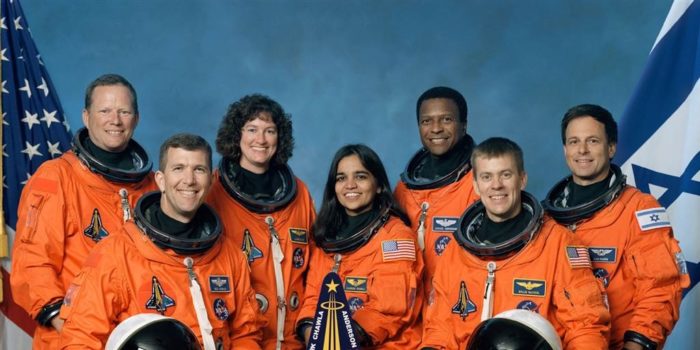
Columbia crew From left to right: David Brown, Rick Husband, Laurel Clark, Kalpana Chawla, Michael Anderson, William McCool, Ilan Ramon
At just over 81 seconds after the Columbia left the ground, it was noticed that yet again a piece of foam had broken free from the external fuel tank. This time, the piece was approximately the size of a suitcase. Had they known, what would have been of even more concern, the piece of foam had struck the left wing creating a small but ultimately deadly hole.
The unaddressed concerns of the falling foam were about to bite NASA hard. And, demonstrated that the hard lessons of the Challenger disaster had seemingly not been learned. In her book The Challenger Launch Decision: Risky Technology, Culture, and Deviance at NASA, Diane Vaughn (a sociologist and professor at Columbia University) described this attitude within the ranks of NASA as “normalization of deviance”, [5] and it appeared this normalization of dismissing legitimate concerns had carried on into the early years of the twenty-first century.
Unaware of any problems, once in orbit, the crew went about the planned routines and missions. On the ground meanwhile, engineers and managers were attempting to assess the damage and decide if any action needed to be taken.
Multiple Chances Missed To Alter The Fate Of The Columbia
While the astronauts onboard the Columbia went about their duties, a “debris assessment team” was looking to establish the level of the damage to the shuttle’s wing. Ultimately, however, it was decided that there was no risk to the flight or the reentry of the shuttle.
However, as noted by Jay Barbree, during that time there were multiple chances to intervene and alter the fate of the Columbia. For example, he notes how there were three separate requests made for the Department of Defense to utilize its advanced satellite imagery to capture pictures of the wing so detailed examination could be carried out from the ground while the shuttle remained in orbit. Two of these requests were turned down and a breakdown in communication resulted in the third not making it to the required destination.
In an ironic twist to the events, when the Department of Defense offered the use of its spy satellite to capture close-up images of the wing, the Mission Management Team failed to take advantage of the technology and no close-ups were taken. Close-ups that could have, potentially, saved the lives of the astronauts.
For example, if they had been aware of how serious the damage to the wing was, the crew could have gone about making attempts to repair it sufficiently enough to reenter the planet safely. Another course of action, as noted by Barbree, would have been to have the Atlantis ready to launch in time to have recovered the astronauts – something that could have been achieved. They would then likely allow the stricken Columbia to reenter the atmosphere over the Pacific Ocean.
However, none of these decisions were taken because the general assumption was that the falling foam had not caused damage enough to the Columbia to have presented a danger.
By the 23rd of January, the crew was finally made aware of the foam that struck the wing of the Columbia in an e-mail from flight director, Steve Stich, to Husband and McCool. In the e-mail, Stich claimed there was “no concern” regarding damage to the shuttle, nor about any dangers during reentry. Jay Barbree would note that this was “a head’s up for the crew in case the media asked about the incident”.
A Deadly Reentry
When 1st February rolled around it was time for the Columbia to bring itself out of orbit and back to Earth in Florida. Everything proceeded as normal, to begin with. At 8:15 am (Eastern Time), the Columbia began its descent out of orbit and toward the Earth. Just short of 30 minutes later, over the Pacific Ocean, it reentered the atmosphere.
Almost immediately, the temperatures of the wings began to rise and continued to do so for a little over five minutes. According to the flight data recorder, at 8:48 am the temperature on the left wing was noted to be showing particular strain by comparison to the rest of the vehicle. The Columbia continued its descent, all the while the temperature continuing to rise.
By 8:53 am the air around the shuttle brightened significantly, something seen to anyone who happened to be looking up on the west coast at the time, which several people were.
At 8:54 am, those at mission control realized something was wrong when it was noted that hydraulic fluid temperature sensors in the left wing were no longer working. Incidentally, a second later as the Columbia crossed from California into Nevada, witnesses on the ground recalled seeing a flash of light in the skies overhead.
By 8:59 am, with mission control realizing something was drastically wrong, an attempt was made to contact Husband in the Columbia. He responded briefly but was seeming cut-off mid-word. Another attempt was made several seconds later. Once more, Husband responded, but again his third word was cut short. Contact was not reestablished after that point.
Although the world at large didn’t know anything was wrong at this point, somewhere over Texas, the Columbia burned and disintegrated into somewhere close to 84,000 pieces of debris. All seven on board lost their lives.
Failed Lessons And Dismissive Attitudes
It was expected that the Columbia would land in Florida at 9:16 am. However, when that time came and went, with no sign of the Columbia, it became apparent to the outside world that something had gone wrong. By the time reports – and footage – of falling, glowing debris came to light over Texas, it became all too clear what had happened. The Columbia had burned up upon reentry.
The investigation, incidentally, concluded that the wing had been damaged significantly enough to have caused damage that made the reentry of the Columbia impossible. More damaging to NASA, though, was that they were found to be “co-conspirators” and that the “culture (in NASA) had as much to do with the accident as the foam”.
While perhaps not as shocking as the Challenger disaster (in terms of how the incident was captured fully on film from start to finish), the Columbia disaster was no less deadly or harrowing for the families of those involved. Perhaps more so when it came to light that the failed lessons and dismissive attitude of senior NASA figures that had contributed to the Challenger disaster were still very much a reality in this most recent tragedy.
The short video below examines the Columbia Disaster in a little more detail.
The End Of The Space Shuttle Era
The Shuttle program faced a further two and a half years of non-activity before the Space Shuttle Discovery launched on the 26th of July 2005. However, the announcement of the retirement of the program had been announced almost 18 months previously in January 2004 (although it would run for another six years).
Even that first return-to-flight in July 2005, however, was a close call when it was noted that foam had yet again fallen from the external fuel tank and struck the shuttle during its ascent. On this occasion, the falling foam didn’t damage the shuttle. However, it reminded NASA of the need to tweak this area of concern further.
It was another year before the next launch when the Discovery once more launched from Florida on 4th July 2006. This time, the mission was a complete success with no issues of concern. All remaining shuttle missions went smoothly and with no major concerns. It was, however, clearly the end of an era of space flight and exploration.
The last flight of the Space Shuttle program occurred in July 2011 when the Discovery landed after the final two-week mission.
You can view news footage of that last mission below.
All In All, Was The Shuttle Program (A Partial) Failure?
It would appear that there are differing opinions [6] as to whether NASA’s Space Shuttle program was a success or not. Not least due to the two disasters that cost the lives of 14 astronauts but also because rather than increase our collective reach into space, it seemingly narrowed it to only several hundred miles above the Earth.
This, at least partially and according to some, was due to the United States Air Force and their increasing demands for shuttle missions to place American satellites into space. There were even demands for the shuttles to act as spies on Soviet activities by having them fly directly above the poles and, if possible, capture Soviet satellites.
This, ultimately, would result in design changes to accommodate the extra cargo, as well as requiring increased fuel capacity. And these requests – at least according to some – took away from the original perfect design of the space shuttles.
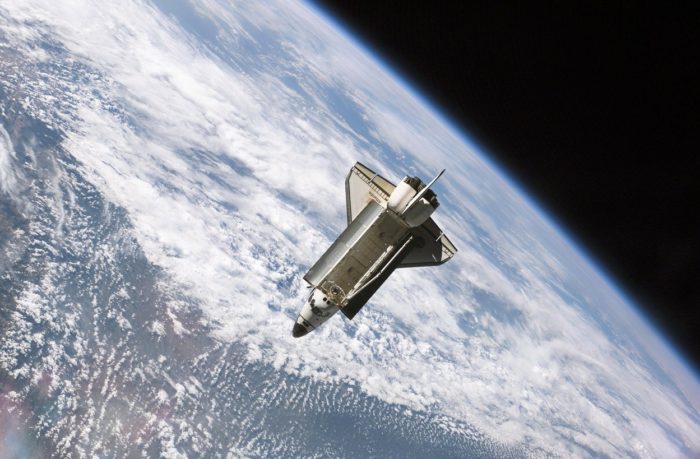
Was the Space Shuttle Program a failure?
There was also a much larger-than-expected financial cost for the Shuttle missions. For example, before the first shuttle was even launched NASA predicted that not only was the space shuttle much cheaper to run, but they would be able to potentially launch a space shuttle on a weekly basis. And what’s more, each launch would “only” cost around $20 million. And this cost is indeed very cheap for space travel. Ultimately, rather than costing “just” $20 million per flight, by the time the program had come to an end the average flight of the 134 missions was a staggering $1.6 billion – almost 50 times than originally predicted.
The Shuttle missions did prove to be vital in taking supplies to the International Space Station, however. As well as playing a major role in the launch of the Hubble Space Telescope. And perhaps ironically, they were able to do this due to the changes made to their design in light of military demands.
Perhaps also of interest, is that the Shuttle Program helped to finish off the Soviet Space Program. And it is there we will turn our attention next.
The Affects Of The Shuttle Program On The Soviet Union
While not something publicly spoken of, both at the time or since, is that the Soviet Union embarked on its own short-lived shuttle program, [7] named Buran, which translates as snowstorm. In reality, though, the Buran shuttles were quite literally based on NASA’s.
What’s more, even though it was the Cold War, the Soviet Union didn’t have to deploy a single spy to get its hands on these plans of the NASA Space Shuttle. They were simply left available to anyone who wished to look at them on databases open to the public, which included the Soviet Union, who wasted little time in getting their hands on the documents. From them, the Buran was born.
The ill-fated Buran program launched just one mission. What the Soviet Union had not envisioned – much like NASA and the United States government themselves – was the overall cost of the Shuttle program. And while the United States was able to burden this extra demand for money, the Soviet Union most certainly couldn’t. Essentially, following the single Buran launch the Soviet Space Program ceased to exist.
Incidentally, and perhaps ironically, while the Buran shuttle never docked with the Mir Space Station, NASA did in 1995. And they did so using the facilities and plans put in place by the Soviet Space Program before its financial ruin.
The short video below examines the Buran shuttles a little further.
The Validity Of The Space Shuttle Era
While the Space Shuttle Program didn’t result in further manned exploration of space or even returning to the Moon as its predecessor Apollo had, their place in space history is valid and assured.
After all, the International Space Station – the permanent human residence in Space – would not have been possible without the Space Shuttle Program. And we might also recall once more the part the Space Shuttle program played in the Hubble Space Telescope, which has allowed us to look further than ever before into the far reaches of space.
And no matter how much weight each of us puts into it, the shuttle missions did, for a time, increase interest in space and space exploration significantly, perhaps more so than since the Apollo missions. It is in part because of NASA’s focus – both intellectually and financially – on the Space Shuttle program that no further missions to the Moon have gone ahead. With the program now retired and the International Space Station established, our collective focus very well may return to further reaches of space.
There is also the lessons learned – sometimes hard ones – that NASA, and indeed any other organization looking to venture out into space need to remember. Indeed, if, as many expect, NASA and other private space agencies do turn their attention much further than previous decades, whether to the Moon once more, or even further afield to Mars or even the moons of Jupiter or Saturn, those harsh lessons of the Space Shuttle program will be invaluable.
The video below examines the Space Shuttle era a little further.
References
| ↑1 | “Live from Cape Canaveral”: Covering the Space Race, from Sputnik to Today, Jay Barbree, ISBN 9780061 735899 |
|---|---|
| ↑2 | Challenger: An American Tragedy: The Inside Story from Launch Control, Hugh Harris, ASIN B00HO12CRC |
| ↑3 | 7 myths about the Challenger shuttle disaster, James Oberg, NBC News, January 26th, 2006 https://www.nbcnews.com/id/wbna11031097 |
| ↑4 | Nasa Conspiracies : The Truth Behind the Moon Landings, Censored Photos, and the face on Mars, Nick Redfern, ISBN 9781601 631497 |
| ↑5 | The Challenger Launch Decision: Risky Technology, Culture, and Deviance at NASA, Diane Vaughan, ISBN 9780226 851761 |
| ↑6 | Why it Failed: The Space Shuttle, Sean Sargeant, Aeronautics Online, September 8th, 2019 https://aeronauticsonline.com/why-it-failed-the-space-shuttle/ |
| ↑7 | Real-Life Rogue One: How the Soviets Stole NASA’s Shuttle Plans, Eric Betz, Discover Magazine, December 14th, 2016 https://www.discovermagazine.com/the-sciences/real-life-rogue-one-how-the-soviets-stole-nasas-shuttle-plans |
Fact Checking/Disclaimer
The stories, accounts, and discussions in this article may go against currently accepted science and common beliefs. The details included in the article are based on the reports, accounts and documentation available as provided by witnesses and publications - sources/references are published above.
We do not aim to prove nor disprove any of the theories, cases, or reports. You should read this article with an open mind and come to a conclusion yourself. Our motto always is, "you make up your own mind". Read more about how we fact-check content here.
Copyright & Republishing Policy
The entire article and the contents within are published by, wholly-owned and copyright of UFO Insight. The author does not own the rights to this content.
You may republish short quotes from this article with a reference back to the original UFO Insight article here as the source. You may not republish the article in its entirety.
